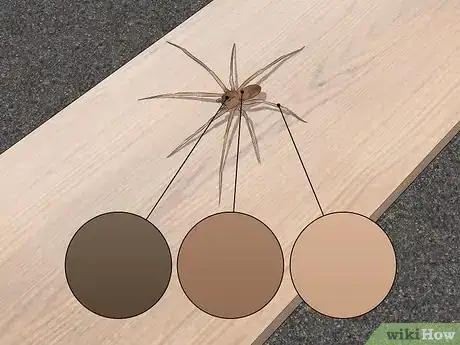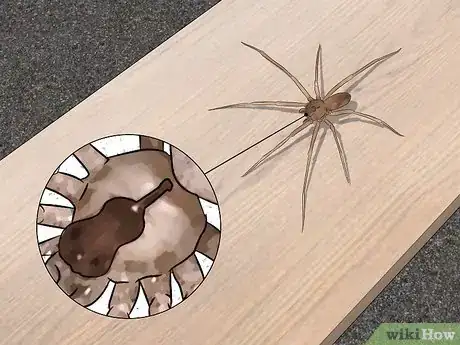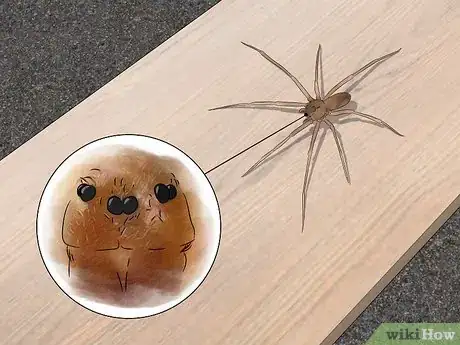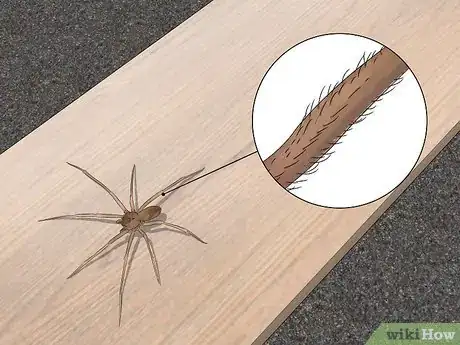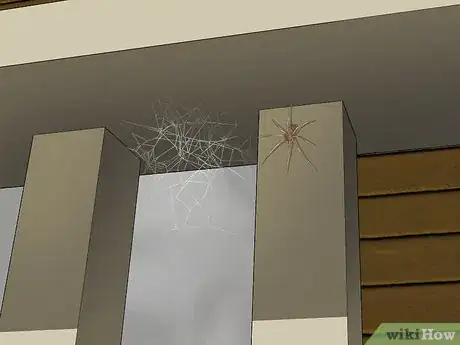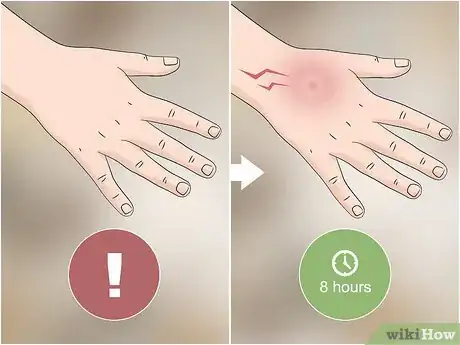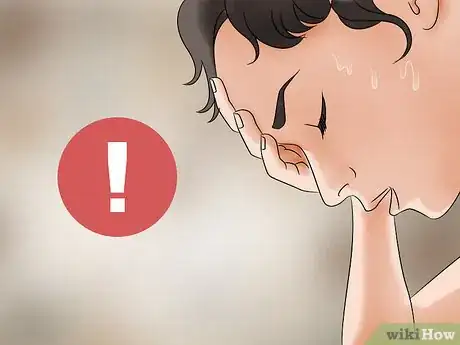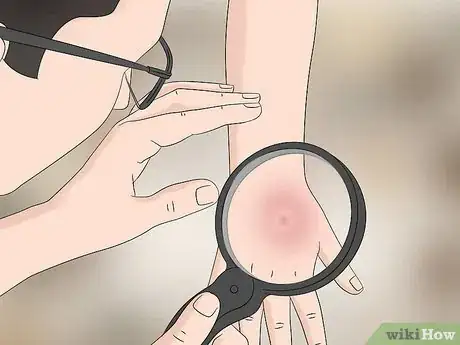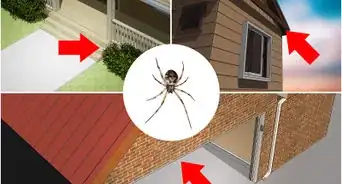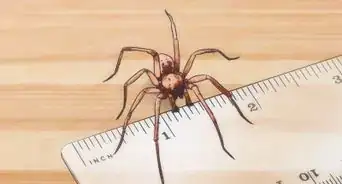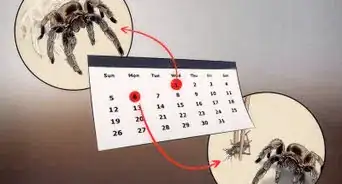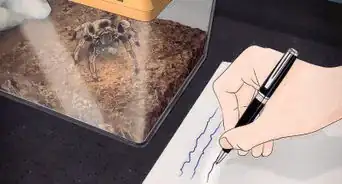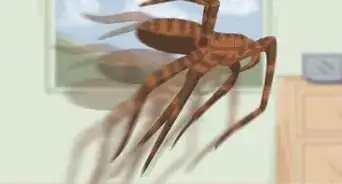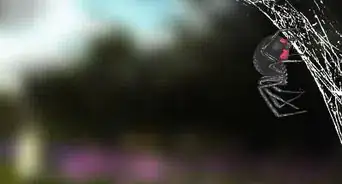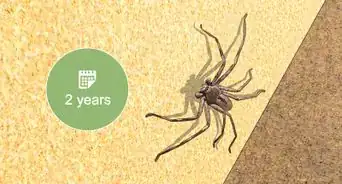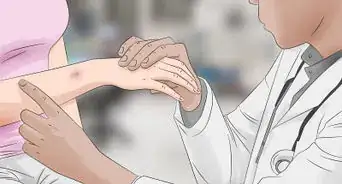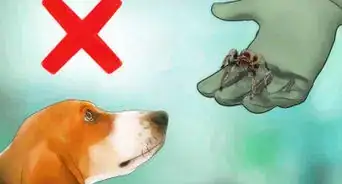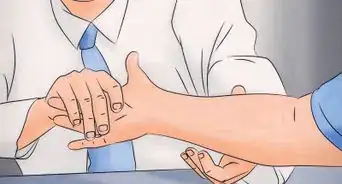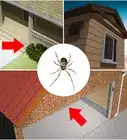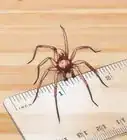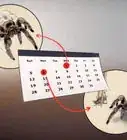This article was co-authored by Samuel Ramsey, PhD. Dr. Samuel Ramsey is an Entomologist and a researcher with the United States Department of Agriculture. Dr. Ramsey has extensive knowledge of symbiosis and specializes in insect disease spread, parasite behavior, mutualism development, biological control, invasive species ecology, pollinator health, and insect pest control. He holds a Bachelor’s degree in Entomology from Cornell University and a Ph.D. in Entomology from the University of Maryland. Dr. Ramsey’s research on bees has enabled researchers to develop targeted control techniques to restore honey bee populations worldwide. He also hosts a YouTube series called “Dr. Buggs.”
wikiHow marks an article as reader-approved once it receives enough positive feedback. This article received 53 testimonials and 94% of readers who voted found it helpful, earning it our reader-approved status.
This article has been viewed 2,775,455 times.
The brown recluse spider, also known as the violin spider, is a venomous creature whose bite can cause children and adults to become ill. The brown recluse is unusual because it has only six eyes (most spiders have eight) and wears a violin-shaped marking on its back. If you live in a region that is home to brown recluse spiders, it's a good idea to learn how to identify them. Read on to find out more about how to spot a brown recluse.
Steps
Identification Chart
Learning to Identify Specific Features
-
1Look at the color. A brown recluse has a dirt or sandy brown body with a slightly darker marking at its center; they can also be dark brown and even slightly yellow. Its legs are a lighter brown and completely uniform in color, with no additional markings.
- If the spider has stripes or other pigments on its legs, it's not a brown recluse.
- If the spider has more than two pigments on its body other than the violin (and maybe a slightly darker abdomen), it's not a brown recluse.
- If the spider has legs that are significantly darker than its body, it's not a brown recluse. Keep in mind slight variation can exist in shade and tone.
-
2Examine the violin shape on the spider's body.[1] It's a slightly darker brown color than the rest of the body, or cephalothorax. The violin shape isn't clearly defined, so it may not look to you exactly like the musical instrument.
- Many spiders have similar shapes on their bodies, so this alone is not significant enough to identify the spider as a brown recluse.
- Again, look at the color of the violin shape closely. If it has spots of different pigments, then you are not looking at a recluse. However, injury or sun damage may also cause what would appear as different coloring or texture.
Advertisement -
3Count the eyes. The brown recluse, unlike other spiders, has only six eyes. They are arranged in pairs: one pair is in the center, and there's a pair on either side. Because the eyes are so small, it can be difficult to see them without a magnifying glass. If you count eight eyes, you're not looking at a recluse. (Please be safe when counting - you don't want to conclude there are six just to have it suddenly bite you!)
-
4Look for fine hairs. The brown recluse has many fine, short hairs on its body. Unlike some other spiders, it does not have spines on its body or legs. If you see a spider with spines, it's definitely not a recluse.
-
5Check the body width. The brown recluse's body doesn't grow to be larger than 1⁄2 inch (1.3 cm). If you're looking at a spider that's larger than this, it's a different type of spider.
Checking Out the Recluse's Habitat
-
1Know what regions recluses inhabit. The brown recluse lives in the southeastern United States. Populations are established in 15 states: Alabama, Arkansas, Georgia, Illinois, Indiana, Iowa, Kansas, Kentucky, Louisiana, Mississippi, Missouri, Ohio, Oklahoma, Tennessee, and Texas.If you don't live in this region, then it is highly unlikely that you will encounter a brown recluse, although it is possible.[2] Contrary to popular myth, brown recluse spiders do not live in California.
-
2Know where brown recluses like to reside. True to their name, brown recluse spiders build their webs in out-of-the way places that aren't usually in plain sight.[3] Brown recluses usually build webs in places that are dry and haven't been recently disturbed. Here are a few places you may spot them:
- Rotting bark
- Attics
- Basements
- Closets
- Sheds
- Barns
- Woodpiles
- Shoes
- Dressers
- Toilets
- Cardboard boxes
- Behind pictures
- In unused beds
-
3Look for the recluse's web. Brown recluse webs are loose, sticky, and off-white or grayish.[4] You won't see a brown recluse web strung between trees or walls - that type of web is built by an orb weaver.
Deciding if You Have Brown Recluse Bite
-
1Be aware of how the bite feels. The initial bite of the brown recluse usually doesn't cause pain. This means that you may not be aware of the bite for as long as 8 hours, at which time the bite area will become red, tender and swollen.
-
2
-
3Seek medical treatment. The danger with a bite from this spider is severe tissue damage, and in rare cases it can cause someone to fall into a coma.[6] Seek medical treatment as soon as you realize you were bit by a brown recluse. Seek immediate medical attention if a child or an elderly person has been bitten; the bite of the brown recluse spider is most dangerous to such persons and can produce very severe symptoms. While waiting to get medical treatment, you can take these immediate first-aid steps:
- Wash the bite area with soap and water
- Apply an ice pack directly to the bite area for ten minutes, then remove it for ten minutes.
- Repeat until you reach medical facilities.
Expert Q&A
Did you know you can get expert answers for this article?
Unlock expert answers by supporting wikiHow
-
QuestionAre brown recluses dangerous?
 Samuel Ramsey, PhDDr. Samuel Ramsey is an Entomologist and a researcher with the United States Department of Agriculture. Dr. Ramsey has extensive knowledge of symbiosis and specializes in insect disease spread, parasite behavior, mutualism development, biological control, invasive species ecology, pollinator health, and insect pest control. He holds a Bachelor’s degree in Entomology from Cornell University and a Ph.D. in Entomology from the University of Maryland. Dr. Ramsey’s research on bees has enabled researchers to develop targeted control techniques to restore honey bee populations worldwide. He also hosts a YouTube series called “Dr. Buggs.”
Samuel Ramsey, PhDDr. Samuel Ramsey is an Entomologist and a researcher with the United States Department of Agriculture. Dr. Ramsey has extensive knowledge of symbiosis and specializes in insect disease spread, parasite behavior, mutualism development, biological control, invasive species ecology, pollinator health, and insect pest control. He holds a Bachelor’s degree in Entomology from Cornell University and a Ph.D. in Entomology from the University of Maryland. Dr. Ramsey’s research on bees has enabled researchers to develop targeted control techniques to restore honey bee populations worldwide. He also hosts a YouTube series called “Dr. Buggs.”
Entomologist The bite of a Brown Recluse has a type of necrotoxin that actually breaks down healthy human skin and flesh in a way that is frightening and conspicuous and concerning. However, it is important to know that most Brown Recluse bites do not result in that necrotized wound growing that won't heal. That only happens for some people and it is an infrequent occurrence. It is even less likely that one will be bitten by these spiders because they are so reclusive. They tend not to spend much time interacting with human beings.
The bite of a Brown Recluse has a type of necrotoxin that actually breaks down healthy human skin and flesh in a way that is frightening and conspicuous and concerning. However, it is important to know that most Brown Recluse bites do not result in that necrotized wound growing that won't heal. That only happens for some people and it is an infrequent occurrence. It is even less likely that one will be bitten by these spiders because they are so reclusive. They tend not to spend much time interacting with human beings. -
QuestionShould I be worried about being bitten if there's a brown recluse in my home?
 Samuel Ramsey, PhDDr. Samuel Ramsey is an Entomologist and a researcher with the United States Department of Agriculture. Dr. Ramsey has extensive knowledge of symbiosis and specializes in insect disease spread, parasite behavior, mutualism development, biological control, invasive species ecology, pollinator health, and insect pest control. He holds a Bachelor’s degree in Entomology from Cornell University and a Ph.D. in Entomology from the University of Maryland. Dr. Ramsey’s research on bees has enabled researchers to develop targeted control techniques to restore honey bee populations worldwide. He also hosts a YouTube series called “Dr. Buggs.”
Samuel Ramsey, PhDDr. Samuel Ramsey is an Entomologist and a researcher with the United States Department of Agriculture. Dr. Ramsey has extensive knowledge of symbiosis and specializes in insect disease spread, parasite behavior, mutualism development, biological control, invasive species ecology, pollinator health, and insect pest control. He holds a Bachelor’s degree in Entomology from Cornell University and a Ph.D. in Entomology from the University of Maryland. Dr. Ramsey’s research on bees has enabled researchers to develop targeted control techniques to restore honey bee populations worldwide. He also hosts a YouTube series called “Dr. Buggs.”
Entomologist People are most frequently bitten if a Brown Recluse, for whatever reason, ends up inside of a shoe and someone sticks their foot inside, crushes it, and in its last-ditch effort to get away from what it thinks is a predator, it bites them. However, they very infrequently actually bite human beings.
People are most frequently bitten if a Brown Recluse, for whatever reason, ends up inside of a shoe and someone sticks their foot inside, crushes it, and in its last-ditch effort to get away from what it thinks is a predator, it bites them. However, they very infrequently actually bite human beings.
Warnings
- The brown recluse is not a particularly aggressive arachnid; this spider will tend to only strike at you if it gets trapped against your skin - something that happens most often when you roll over in bed or put on clothing. Most bites are done in self-defense because the spider feels threatened.⧼thumbs_response⧽
- If you live in an area where brown recluse spiders are prevalent, it is wise to shake out your bed linens and blankets before going to bed. You should also check your shoes and slippers before putting them on; this spider is likely to crawl into them during the night.⧼thumbs_response⧽
- This spider cannot bite through clothing, so be sure to wear heavy-duty gloves and long sleeves if you are sorting through plastic bags, boxes, or other materials.⧼thumbs_response⧽
References
- ↑ Samuel Ramsey, PhD. Entomologist. Expert Interview. 20 January 2021.
- ↑ http://ento.psu.edu/extension/factsheets/brown-recluse-spiders
- ↑ Samuel Ramsey, PhD. Entomologist. Expert Interview. 20 January 2021.
- ↑ http://ohioline.osu.edu/hyg-fact/2000/2061.html
- ↑ http://www.nlm.nih.gov/medlineplus/ency/article/002859.htm
- ↑ http://www.nlm.nih.gov/medlineplus/ency/article/002859.htm
About This Article
A brown recluse is a brown spider that's roughly the size of a penny. It has long, thin legs. Brown recluses have a dark brown violin-shaped marking on their thorax, and their body is covered in thin hairs. Brown recluses only have 6 eyes, while most spiders have 8. If you think a spider is a brown recluse, don’t get too close to examine Brown recluse bites are dangerous and potentially deadly. Brown recluses prefer to hide in dark, hidden places, like under a porch or deep in a closet. They are only found in the Central and Southern United States. For information on where brown recluses live and how to identify a bite, keep reading!

